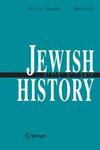The Wars in Eastern Europe, the Jews of Jerusalem, and the Rise of Sabbateanism: The Shaping of the Jewish World in the Mid-Seventeenth Century
IF 0.4
2区 历史学
Q2 HISTORY
引用次数: 0
Abstract
This paper revisits the question of the connection between the wars in Eastern Europe (beginning with gezeirot taḥ ve-tat in 1648) and the rise of Sabbateanism. It argues that the key issue is the ways in which the Ashkenazi Jews of Jerusalem dealt with the collapse of Polish-Lithuanian Jewish funding for the Land of Israel in the wake of the wars. Following 1648, an extended transregional philanthropic network began to support the relief efforts for Polish Jewry, diverting resources from the Land of Israel. Initially, this caused great suffering in Jerusalem, including a famine in which many, particularly women, died. In response, great pressure was put on the philanthropic network supporting Jewish settlement in the Land of Israel: the Ashkenazi women of Jerusalem tried to establish their own independent fundraising mechanism, while the men employed a Polish Jew, Nathan Shapira, to collect for them. A major kabbalist, Shapira found common ground with millenarian Protestants in north-western Europe, who saw in the suffering of the Jews in both Eastern Europe and the Holy Land a sign of the Messiah’s imminent return. When they sent money to Jerusalem, the local community—including Nathan of Gaza, then a student—was forced to consider its attitude towards them and their ideology. Nathan had grown up in the post-1648 expanded world of philanthropy and, after the appearance of Shabbetai Zvi, used many transregional fundraising strategies with great success to help spread the new messianic movement.东欧战争,耶路撒冷的犹太人,安息日教的兴起:17世纪中叶犹太世界的形成
本文重新探讨了东欧战争(始于1648年的gezeirot taamave -tat)与安息日主义兴起之间的关系。它认为,关键问题是耶路撒冷的德系犹太人如何应对战后波兰立陶宛犹太人对以色列土地的资助崩溃。1648年后,一个扩展的跨地区慈善网络开始支持波兰犹太人的救济工作,从以色列土地上转移资源。起初,这在耶路撒冷造成了巨大的痛苦,包括饥荒,许多人,特别是妇女,死亡。作为回应,支持犹太人在以色列土地上定居的慈善网络受到了巨大的压力:耶路撒冷的德系犹太人妇女试图建立自己的独立筹款机制,而男性则雇佣了波兰犹太人内森·夏皮拉(Nathan Shapira)为她们筹款。作为主要的卡巴拉学家,夏皮拉与西北欧的千禧年新教徒找到了共同点,他们在东欧和圣地的犹太人的苦难中看到了弥赛亚即将回归的迹象。当他们向耶路撒冷汇款时,当地社区——包括当时还是学生的加沙的内森——被迫考虑对他们和他们的意识形态的态度。内森在1648年后的慈善世界中长大,在Shabbetai Zvi出现后,他使用了许多跨地区的筹款策略,并取得了巨大的成功,帮助传播了新的弥赛亚运动。
本文章由计算机程序翻译,如有差异,请以英文原文为准。
求助全文
约1分钟内获得全文
求助全文
来源期刊

Jewish History
HISTORY-
CiteScore
0.40
自引率
33.30%
发文量
10
期刊介绍:
The purpose of Jewish History, the sole English-language publication devoted exclusively to history and the Jews, is to broaden the limits of historical writing on the Jews. Jewish History publishes contributions in the field of history, but also in the ancillary fields of art, literature, sociology, and anthropology, where these fields and history proper cross paths. The diverse personal and professional backgrounds of Jewish History''s contributors, a truly international meeting of minds, have enriched the journal and offered readers innovative essays as well as special issues on topics proposed by guest editors: women and Jewish inheritance, the Jews of Latin America, and Jewish self-imaging, to name but a few in a long list.
 求助内容:
求助内容: 应助结果提醒方式:
应助结果提醒方式:


